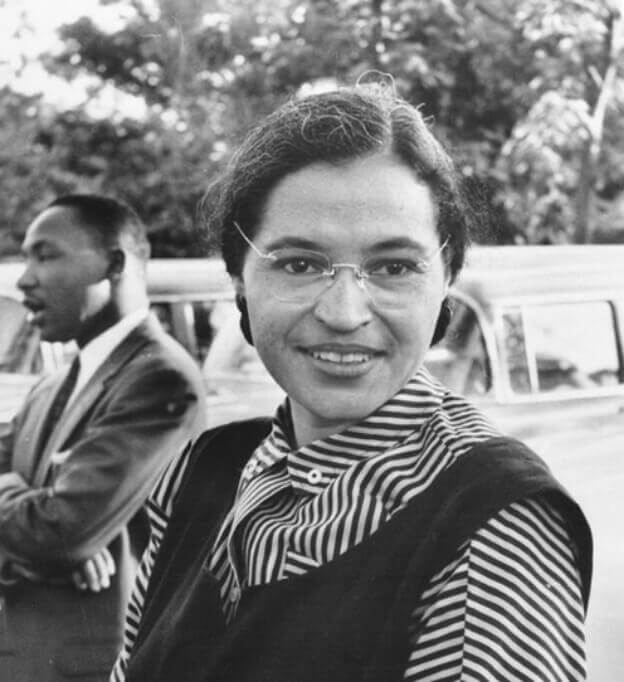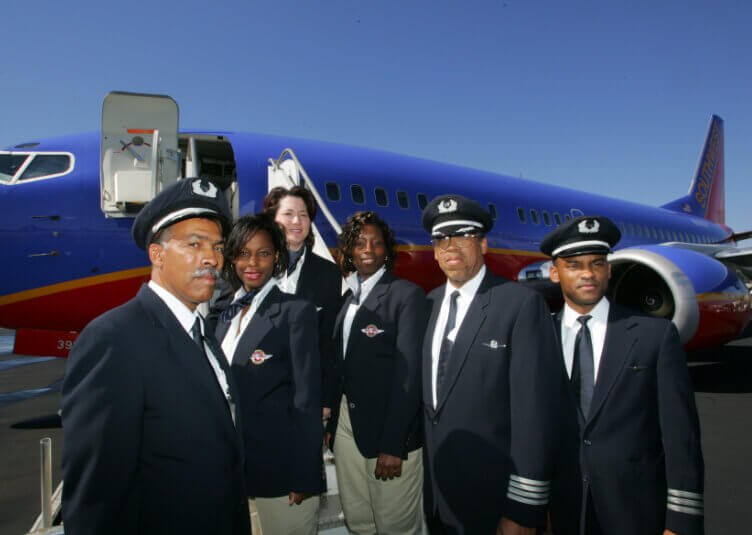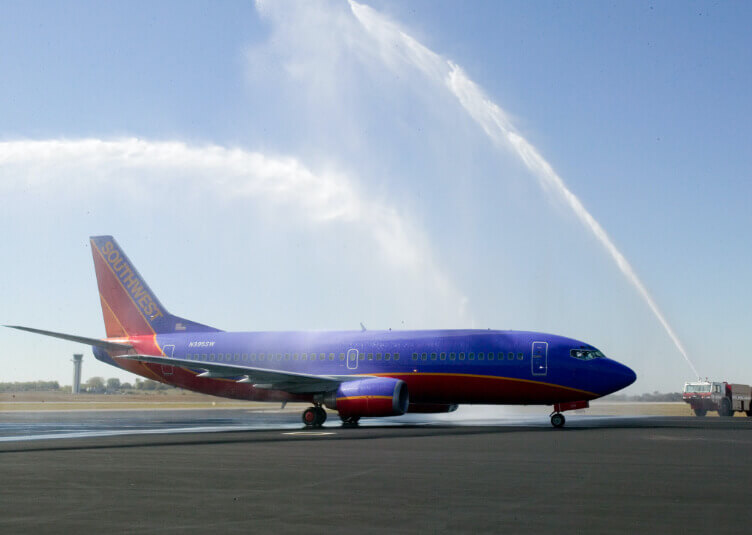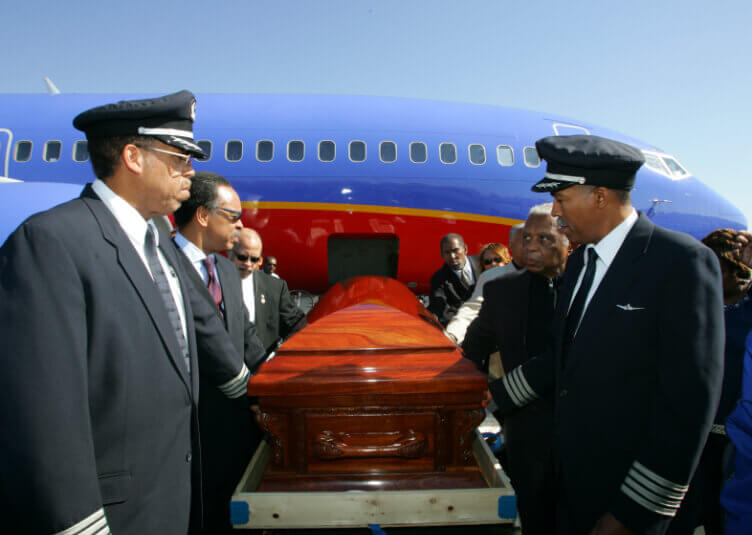
Rosa Parks and Dr. Martin Luther King Jr. in 1955
Parks’ Place: The Last Flight of Rosa Parks
When Rosa Parks, one of the soft-spoken champions of the Civil Rights movement, passed away on October 24, 2005, the nation, as a whole, seemed to rise in her honor.
Admirers used whatever tools and talents might be at their disposal to commemorate her life. The United States Senate—in a rare show of political unity—unanimously approved a resolution honoring her achievements. Newspapers across the country filled editorial pages with heartfelt remembrances. Various organizations and universities staged public tributes. And in Montgomery, Alabama, and Detroit, city officials cordoned off the front seats of their city buses in her memory.
Amid this dramatic outpouring of support, civil rights leaders, sought to organize one final farewell for a true American hero: an ambitious multi-day, multi-city procession of Mrs. Parks’ body before it was laid to rest.
They reached out to Southwest to aid its efforts.
Karen Price-Ward, the Community Outreach National Strategic Relationships Lead for Southwest at the time, embraced the idea of providing chartered airline support for the procession and pitched the idea to other Southwest Leaders.
Then-President Colleen Barrett green-lit the request without hesitation. It didn’t matter that Mrs. Parks’ homecoming—a circuitous journey snaking from Detroit to Alabama up the Atlantic Coast to Washington, D.C., and then back to Detroit—would require substantial expense and produce a host of logistical obstacles.
Case in point: In order to pick up dignitaries, celebrities, and friends of the Parks family in Montgomery, Alabama—where Southwest didn’t offer service—it would need special landing approvals. And then there was the host of challenges involved in making timely pickups and drop-offs based on a constantly shifting schedule.
Nevertheless, Southwest was up for any challenge that might come its way. The Company considered it an honor to provide Mrs. Parks the homecoming she deserved, and it knew precisely the man who should captain the flight: Chief Pilot Lou Freeman.
Initially hired by Southwest in 1980, Lou earned the distinction in 1992 of becoming the first African-American Chief Pilot of a major U.S. airline. He was a beloved figure within Southwest, a role model worthy of shepherding Mrs. Parks to her final resting place. Joining Lou would be a diverse Crew, including Flight Deck Crew Captain Richard Turner and First Officer Trevor Hinton, as well as Inflight Supervisors Yolanda Gabriel, Rita Tubilleja, and Renee Gordon.
What none of these Crewmembers could fully anticipate, however, was just how profound of an experience the journey would turn out to be.

Captain Lou Freeman, second from right, poses with the Flight Crew for the final flight of Rosa Parks. On the left is Captain Richard Turner, and on the right is First Officer Trevor Hinton. Behind them are Inflight Supervisors Yolanda Gabriel, Rita Tubilleja, and Renee Gordon
When the plane bearing Mrs. Parks’ body touched down in Montgomery, Alabama, on October 29, 2005, fire trucks arched streams of water over its runway in a special water cannon salute to mark its arrival. The scene literally brought tears to Lou’s eyes, as he was well aware that 50 years earlier fire hoses had been used as weapons against civil rights leaders in Montgomery instead of as tributes.

The ground crew in Montgomery salutes the arrival of Rosa Parks with water cannons.
It had been in Montgomery, on December 1, 1955, that Mrs. Parks—then a 42-year-old seamstress—was arrested and fined $10 plus $4 in court costs for refusing to give up her seat to a white man on a city bus. “My feet were not hurting,” said Parks years later. “I was tired in a different way.”
Yet it was that righteous fatigue—channeled by a woman who showed the courage to make a vital stand—that helped galvanize a movement to transform a nation.
The mile-long motorcade that traveled across Montgomery, Alabama, after Mrs. Parks’ passing, marked key locations and moments from her life. When it drove through a street named in Mrs. Parks’ honor, residents from all walks of life emerged to bow their heads and wave their hands. There were visits to various churches, including St. Paul African Methodist Episcopal Church where Mrs. Parks was a longtime member, before Lou—who’d been named an honorary pallbearer—supervised the return of Mrs. Parks body to the plane and flew toward Washington, D.C.
To mark the completion of this leg of the journey, Lou and his fellow Pilots banked the wings of the plane as it departed Montgomery—providing the city a kind of final salute to Mrs. Parks.
Upon landing in Baltimore, Maryland and transporting her to Washington, D.C., her body was granted a rare distinction: On October 30, 2005, she became the first woman laid in honor at the Capitol Rotunda. Numerous Civil Rights champions, government officials, President George W. Bush and first lady, Laura Bush, and religious leaders delivered speeches. But the outpouring of grief and the validation by thousands of everyday supporters would likely have touched Mrs. Parks just as deeply. “It was unreal,” said Karen, recalling the events in Washington, D.C., “to think that Southwest Airlines was a part of such a historic moment.”
And still the journey—like the movement itself—carried onward, making its way back to Detroit, where the body of Rosa Parks was eventually delivered to the Greater Grace Temple Church for her final funeral service on November 2, 2005.
A line of mourners hoping to claim one of the 2,000 available seats stretched for blocks. The funeral, which originally was scheduled to last three hours, stretched on for more than seven. Upon its conclusion, Rosa Parks’ body was placed onto an antique gold-trimmed horse-drawn carriage and delivered to her final resting place in Detroit’s Woodlawn Cemetery.
Lou, who brought his family to witness the final service, summed up the feelings of Southwest and his entire Crew when he remarked that they were the lucky ones, for they had been given the honor of “touching something that was going to last forever.”

Captain Lou Freeman, left, and Captain Richard Turner with the casket of Rosa Parks.
